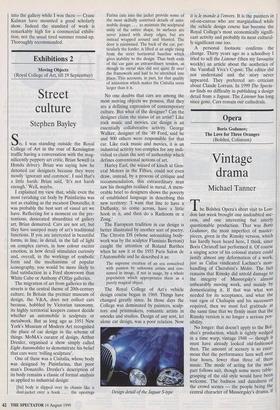Exhibitions 2
Moving Objects
(Royal College of Art, till 19 September)
Street culture
Stephen Bayley
So, I was standing outside the Royal College of Art in the roar of Kensington traffic having a conversation with the mag- nificently peppery art critic, Brian Sewell (a Honda driver). Brian was saying how he detested car designers because they were mostly 'ignorant and conunon'. I said that's a little harsh. Brian said, 'It's not harsh enough.' Well, maybe.
I explained my view that, while even the most ravishing car body by Pininfarina was not as exalting as the meanest Donatello, it was probably the best sort of visual art we have. Reflecting for a moment on the pre- tentious, desiccated absurdities of gallery art, Brian demurred. Cars are not art, but they have usurped many of art's traditional functions. If you are interested in beautiful forms, in line, in detail, in the fall of light on complex curves, in how colour excites emotion, in how detail stimulates curiosity and, overall, in the workings of symbolic form and the mechanisms of popular iconography, you would be more likely to find satisfaction in a Ford showroom than White Cube or Anthony d'Offay galleries.
The migration of art from galleries to the streets is the central theme of 20th-century culture. In Britain the premier museum of design, the V&A, does not collect cars because, hobbled by Victorian taxonomy, its highly territorial keepers cannot decide whether an automobile is sculpture or metalwork. But as long ago as 1951 New York's Museum of Modern Art recognised the place of car design in the scheme of things. MoMA's curator of design, Arthur Drexler, organised a show simply called Eight Automobiles to demonstrate his belief that cars were 'rolling sculpture'.
One of these was a Cisitalia, whose body was designed by Pininfarina, that poor man's Donatello. Drexler's description of its body remains a classic of formal analysis as applied to industrial design:
[Its] body is slipped over its chassis like a dust-jacket over a book ... the openings
Farina cuts into the jacket provide some of the most skilfully contrived details of auto- mobile design .. . to maintain the sculptural unity of the entire shape, its surfaces are never joined with sharp edges, but are instead wrapped around and blunted. The door is minimised. The back of the car, par- ticularly the fender, is lifted at an angle rising from the strict horizontal baseline which gives stability to the design. Thus both ends of the car gain an extraordinary tension, as though its metal skin did not quite fit over the framework and had to be stretched into place. This accounts, in part, for that quality of animation which makes the Cisitalia seem larger than it is.
No one doubts that cars are among the most moving objects we possess, that they are a defining expression of contemporary culture. But what of the designer? Can the designer claim the status of an artist? Like rock music and movies, car design is an essentially collaborative activity. George Walker, designer of the '49 Ford, said he and 900 others were responsible for that car. Like rock music and movies, it is an industrial activity too complex for any indi- vidual to claim the sort of authorship which defines conventional notions of art.
Harley Earl, the wizard of kitsch at Gen- eral Motors in the Fifties, could not even draw, instead, by a process of critique and recommendation, this extraordinary man saw his thoughts realised in metal. A mem- orable brief to designers shows the poverty of established language in describing this new territory: 'I want that line to have a Duflunky, to come across, have a little hook in it, and then do a Rashoom or a Zong.'
The European tradition in car design is better illustrated by another sort of poetry. The Citroen DS (whose astonishing body- work was by the sculptor Flaminio Bertoni) caught the attention of Roland Barthes when he saw it at the 1955 Paris Salon de l'Automobile and he described it as:
The supreme creation of an era conceived with passion by unknown artists and con- sumed in image, if not in usage, by a whole population which appropriates them as a purely magical object.
The Royal College of Art's vehicle design course began in 1969. Things have changed greatly since. In those days the College was dominated by painters, sculp- tors and printmakers, romantic artists in smocks and studios. Design of any sort, let alone car design, was a poor relation. Now Design detail of the Jaguar S-type it is le monde a l'envers. It is the painters in oil-on-canvas who are marginalised while the vehicle design course has become the Royal College's most economically signifi- cant activity and probably its most cultural- ly significant one too.
A personal footnote confirms the change. Thirty years ago as a schoolboy I tried to sell the Listener (then my favourite weekly) an article about the aesthetics of the Vauxhall Viva's C-post. The editor did not understand and the story never appeared. They preferred art. criticism about Claude Lorrain. In 1999 The Specta- tor finds no difficulty in publishing a design detail from a Jaguar. The Listener has long since gone. Cars remain our cathedrals.


























































 Previous page
Previous page